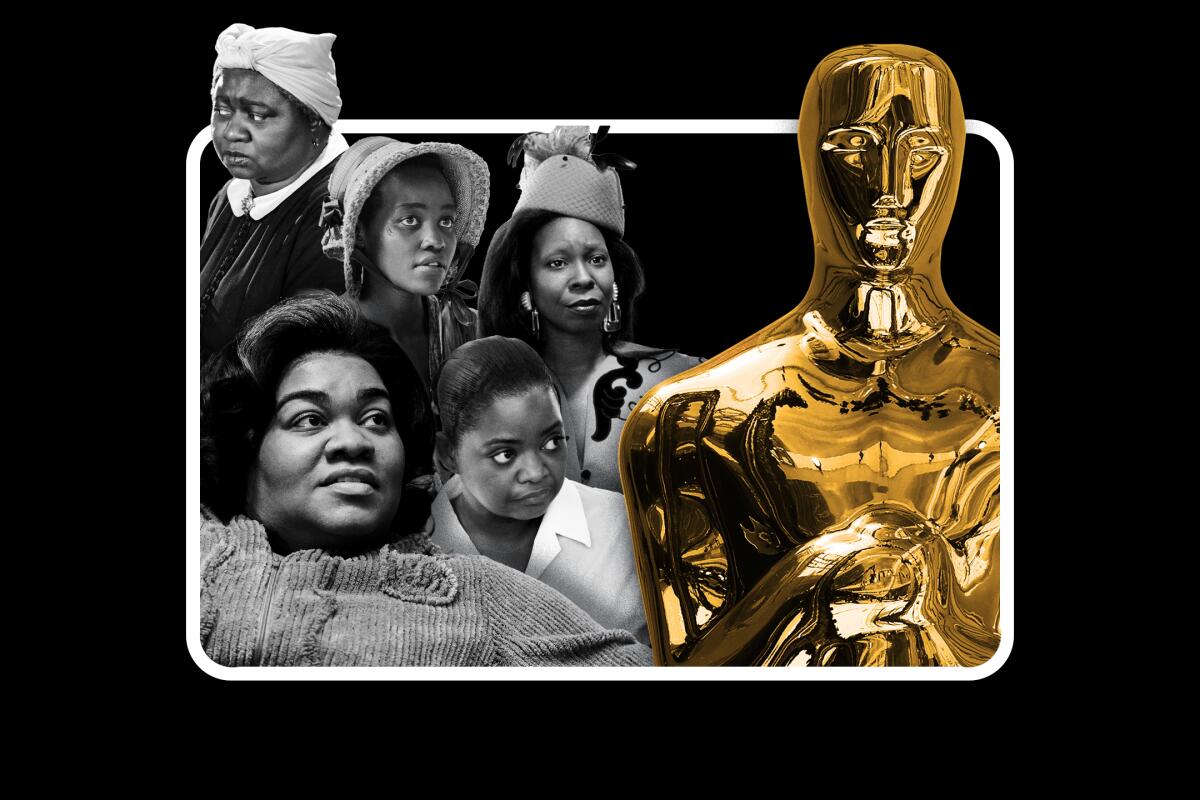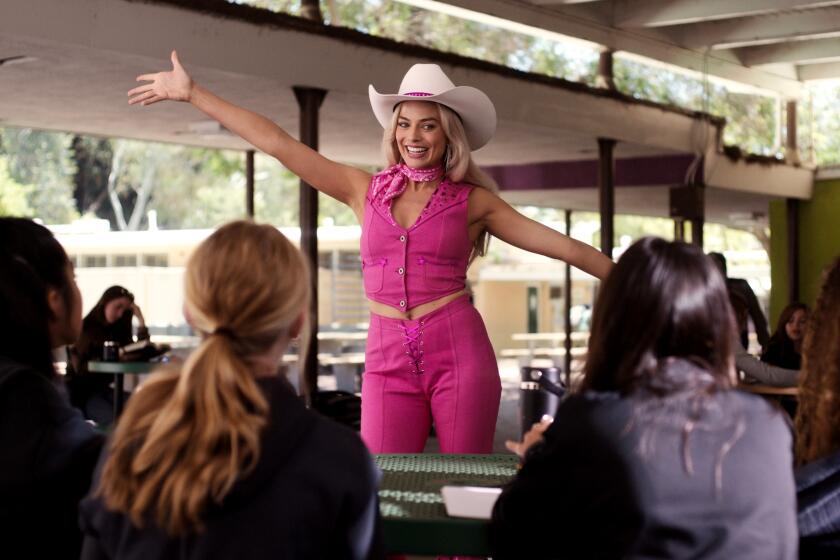84 years after Hattie McDaniel, the Oscars still put Black women in a box

- Share via
As the countdown to the 96th Academy Awards winds to an end, little suspense hovers over who will win the Oscar for supporting actress. And that all-but-certain outcome is both good news and bad.
First, the good news: Barring a huge upset, Da’Vine Joy Randolph — nominated for her poignant performance in “The Holdovers” as Mary Lamb, the head cook at an elite New England boarding school — is headed for the winners circle, continuing a streak that so far has included a Golden Globe, a Screen Actors Guild award and an Indie Spirit award.
Now the bad news: A Randolph win would continue the motion picture academy‘s decades-long tradition of honoring Black women who play characters subservient to white people or in roles that operate in support of white characters — while honoring them for little else.
To be clear, the issue here is not with the perceptive and nimble Randolph, for whom a win would be the well-deserved culmination of a string of impressive screen performances in such wide-ranging productions as “Dolemite Is My Name,” “High Fidelity” and “Only Murders in the Building.”
The question now, heading into the 96th Academy Awards on Sunday, is how many Oscars will “Oppenheimer” win from its 13 nominations?
But in the through line from Hattie McDaniel, the first Black winner in this category, to Randolph, likely the newest, it is difficult not to read a troubling tendency among Oscar voters: When it comes to determining what work deserves recognition, the academy still puts Black women in a box.
To date, only 10 Black actresses have won an Oscar, and Halle Berry remains the only one to have triumphed in the lead category, for her role in 2001’s “Monster’s Ball.” (The numbers for Black women are even more dire in the nonacting categories.)
And it was through McDaniel, who made history in 1940 as the first Black performer to win an Oscar for her portrayal as Mammy, the house slave in “Gone With the Wind,” that the academy established its pattern: awarding Black female performers almost exclusively in supporting roles, many of them in literal or figurative service to the white characters around them.
That list includes Whoopi Goldberg as con artist psychic Oda Mae Brown in 1990’s “Ghost,” in which Brown exists exclusively to communicate with the ghost of a murdered banker (Patrick Swayze) determined to punish his killer and protect the love of his life (Demi Moore); Octavia Spencer as maid Minny Jackson in 2011’s “The Help,” a housekeeper who also tends to the emotional needs of a privileged plantation wife (Jessica Chastain) in civil rights-era Mississippi; and Lupita Nyong’o as Patsey in 2013’s “12 Years a Slave,” an enslaved woman who endures rape, a vicious whipping and other abuses at the hands of a sadistic couple (Michael Fassbender and Sarah Paulson) in antebellum Louisiana.
The roll call of Black actresses in subservient roles who were nominated in the category but didn’t win is even more extensive.
Ethel Waters in 1949 became the second Black performer to score an Oscar nomination as an illiterate Southern laundress in “Pinky.” Juanita Moore played a maid catering to actress Lora Meredith (Lana Turner) in 1959’s “Imitation of Life.” Alfre Woodard played a maid to columnist Marjorie Kinnan Rawlings (Mary Steenbergen) in 1983’s “Cross Creek.”
There have been exceptions, of course, such as Jennifer Hudson, who won for playing cast-off singer Effie White in 2006’s “Dreamgirls,” or Viola Davis, who won for her turn as the matriarch of a Black family in midcentury Pittsburgh in the 2016 adaptation of August Wilson’s “Fences.”
And, thankfully, the tempo with which Black women are nominated for and win Oscars, whatever the role, is increasing. (Nominated alongside Randolph this year in the supporting actress category is Danielle Brooks for “The Color Purple.”)
But the limitations placed on Black actresses over the course of Academy Awards history come into particularly sharp relief when compared to the range of roles portrayed by Black men who’ve won acting Oscars. Of the five who’ve walked away with a statuette for lead, and especially the six who’ve done so for supporting, a far greater proportion have won for playing characters in positions of authority (Louis Gossett Jr., “An Officer and a Gentleman”), celebrity (Cuba Gooding Jr., “Jerry Maguire”) or political influence in their own right (Daniel Kaluuya, “Judas and the Black Messiah”).
You might even say that the expressive, moving Randolph has received such rightful acclaim for her performance because her strength in the role overcomes the more deferential aspects of Mary’s character.
For the record:
11:14 a.m. March 11, 2024An earlier version of this story misidentified two of “The Holdovers’” Oscar nominations. David Hemingson, not Alexander Payne, was nominated for original screenplay, and Payne was not nominated for director.
Her work in “The Holdovers” has been a key element in the film’s popular and critical success. In addition to Randolph, the film is nominated for best picture, lead actor (Paul Giamatti), original screenplay (David Hemingson) and film editing.
Set in 1970, the film centers on Paul Hunham (Giamatti), an ill-tempered classics instructor drafted to remain on campus and supervise the handful of students who can’t go home during the wintry Christmas break. When the rich father of one of the students maneuvers to whisk most of the boys off on vacation, Hunham winds up stuck with Angus Tully (Dominic Sessa), a moody only child who has been abandoned at school by his parents. Teacher and student’s open contempt for each other eventually evolves into an affectionate bond.
Also remaining on campus to manage the school’s cafeteria is Mary, who is so heartbroken over the Vietnam War death of her son Curtis, a former standout at the predominantly white prep school, that she declines an invite from family members living nearby to join them during her holiday. Mary reveals that she took the job in the first place so that her son could receive a first-class education, but she couldn’t afford to send him to college, resulting in him being drafted. The campus was “the last place my baby and I were together,” she tells Hunham, explaining her decision to isolate there: “I feel it’s too soon. Like Curtis would feel I’m abandoning him.”
Randolph vividly depicts Mary’s heartbreak. She wants little to do with others. She smokes heavily and often has a liquor bottle within reach. Even attending a Christmas Eve party is more painful than joyous.
But despite Payne’s claim, explaining his decision to cast Randolph to The Times, that “if she’s stealing every movie she’s in, then it’s time she should be a lead,” Mary might be better described as a third wheel in the story, serving primarily as a bridge between Hunham and Tully as she cooks their meals and grudgingly allows them to join her in the evenings as she watches “The Newlywed Game.”
Pundits have several races already pegged, but here are the films that ought to leave triumphant — as well as some that deserved to be in the conversation.
This is as much a function of the context around Mary, or lack thereof, as the character herself. Where Hunham’s bitter feud with the school’s administration and Tully’s troubled home life are explored in some detail, we’re left to fill in the blanks ourselves when it comes to the racial dynamic for a Black mother and her late son at a lily white institution, or for the atmosphere in Boston on the eve of its most ferocious battles over school desegregation.
Instead, Mary becomes heartbreak personified, her grief broken only by her disdain for her job: She refers to the students as “royal little a—” and declares her frustration at having to prepare meals for “300 little s—.”
The only other Black figure at the school, a custodian named Danny, is introduced as a potential love interest for Mary, only to be dispatched halfway through the film. Later, when Hunham and Tully plot a getaway to Boston, Mary asks if they can drop her off in nearby Roxbury — she has decided, without explanation, to visit her family after all, particularly her little sister, who is pregnant. But Payne passes up another opportunity to flesh out Mary’s character. Instead, the film switches to scenes showing Hunham and Tully visiting a museum, ice skating and watching a movie.
Some may see such criticisms of “The Holdovers” as nit-picking, or an attempt to rain on Randolph’s parade. But if the film academy is to achieve its vision, advanced since the uproar of #OscarsSoWhite nearly a decade ago, of making the industry’s top honor more inclusive, it can’t simply be about increasing the number of nominees and winners of color. It also needs to recognize a broader, more empowered array of work from Black women — films like “The Woman King” and “Till,” two of the awards’ most controversial recent snubs. Otherwise, the Oscars’ future may continue to look too much like the Oscars’ past.
More to Read
From the Oscars to the Emmys.
Get the Envelope newsletter for exclusive awards season coverage, behind-the-scenes stories from the Envelope podcast and columnist Glenn Whipp’s must-read analysis.
You may occasionally receive promotional content from the Los Angeles Times.













